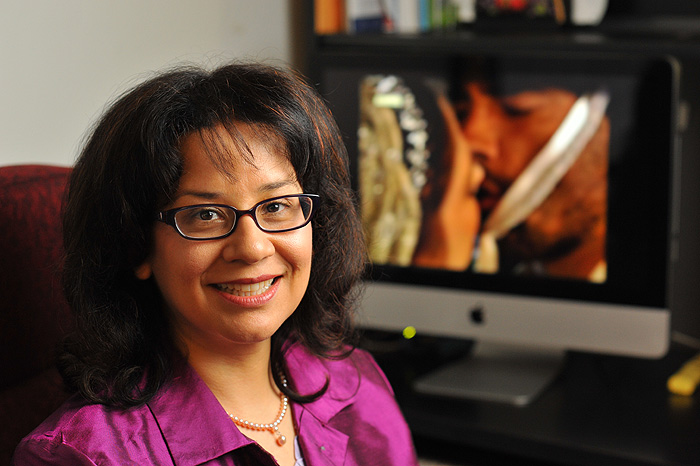
If you think daytime soap operas are passé, consider this: millions are watching Spanish-language soap operas – telenovelas – in prime time, and their availability on digital media has increased and widened audiences.
The telenovelas grab audiences with romance, crime, and drama. But many of them are conveying the wrong messages, especially to young women, says Diana I. Rios, associate professor of communication sciences in the College of Liberal Arts and Sciences and interim director of the Institute of Puerto Rican and Latino Studies.
Rios, co-editor of a new book, Soap Operas and Telenovelas in the Digital Age, says the telenovelas are designed to be very melodramatic even to the point of being funny to some audiences. Also, these programs use plot twists to build audiences.
Telenovelas are very similar to U.S.-made soap operas; both are serialized melodramas, Rios says. But telenovelas are aired at night and “command large audiences by promising vicarious involvement in a virtual social network of friends, lovers, relatives, and communities.”
Since so many family members watch them, they were, especially before the digital age, a family pastime. Unlike daytime American soap operas, which are designed primarily for women, the Latin American-style soaps, imported from Latin America, are geared for a co-ed, multi-generational audience.
Research shows, she adds, that they have influence on audiences, especially on younger audiences who come to accept the sexual stereotypes presented in the material.
“There is a lot of misinformation for teens in the programming,” she says. “These young people are forming their views of society, and it is providing them with a warped picture.”
Both mainstream, daytime soap operas and Spanish-language telenovela imports don’t deal well with issues such as HIV, alcoholism, teen pregnancy, date violence, or how the elderly are treated. And they often don’t portray successful women well, she says. For instance, in U.S. soap operas when there is an African-American female professional such as a doctor, writers can’t seem to figure out what to do with the character or how to create a romance without introducing another African-American character.
“The U.S. soap operas are not keeping up with other types of entertainment,” says Rios, who often writes about pop culture. “And they rely on stereotypes. The man with the Hispanic-sounding name is always very debonair, for example.”
Likewise, the telenovelas contain highly sexualized content without addressing risky behaviors or serious social problems, leaving younger viewers to form opinions based on incomplete or faulty information.
 Rios, who is Mexican-American, says that audiences are watching both telenovelas and U.S. soap operas for entertainment, but are unconsciously picking up a lot of subtle messages not only about morals and values but also about fashion, makeup, and even cereal and shampoo.
Rios, who is Mexican-American, says that audiences are watching both telenovelas and U.S. soap operas for entertainment, but are unconsciously picking up a lot of subtle messages not only about morals and values but also about fashion, makeup, and even cereal and shampoo.
“The problem is that we are not watching them with a critical eye,” she says. “More and more often teenagers are watching them on their smart phones, and adults are not discussing the content with them. People are not viewing them critically.”
One of the telenovelas described in the new book edited by Rios is Fuego en la Sangre, which was the highest-rated premiere in Univision history on April 28, 2008.
“Fuego en la Sangre, like many others shown in the U.S. and distributed widely, contains highly sexualized content but does not address the fact that risky sexual behaviors can result in serious physical and mental challenges and problems.” (from the article, “Fuego en la Sangre Fires Risky Behaviors,” by Petra Guerra, Diana I. Rios, and Robert Forbus)


